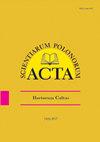The influence of silica upon quantitative, qualitative, and biochemical traits of tomato under water stress
IF 0.6
4区 农林科学
Q4 HORTICULTURE
引用次数: 1
Abstract
Water stress is by far the most serious limiting factor to tomato (Solanum lycopersicom) production, particularly in Iran where located in arid and semi-arid regions. Silicon (Si) is considered an effective element to mitigate the adverse effects of water stress by promoting plant growth and production. Therefore, the present study was designed to evaluate the effects of the foliar application of Si (0, 100, and 200 mg L–1) and three water regimes – no stress (100), mild stress (80%), and severe stress (60%) – on the growth parameters, the yield, and the fruit quality as well as antioxidant status of the tomato. The imposed water stress significantly increased the total soluble solids (TSS), the total acidity (TA), and the flavonoids as well as antioxidant defense parameters such as catalase (CAT) and peroxidase (POX), while the growth parameters (plant height and leaf number) and tomato yield were decreased. In contrast, the foliar application of Si (200 mg L–1) remarkably improved the total yield of tomatoes when exposed to water stress by improving the antioxidant enzyme activities and total flavonoid compounds. In addition, the application of Si could significantly improve the growth parameters (plant height and leaf number) and fruit quality (fruit firmness and size). As a result, the foliar application of Si could be suggested as an effective strategy for imparting water stress resistance in the tomato.二氧化硅对水分胁迫下番茄数量、品质和生化性状的影响
水分胁迫是迄今为止番茄(Solanum lycopersicom)生产最严重的限制因素,特别是在干旱和半干旱地区的伊朗。硅(Si)被认为是通过促进植物生长和生产来减轻水分胁迫不利影响的有效元素。因此,本研究旨在评估叶面施用Si(0、100和200 mg L-1)和三种水处理(无胁迫(100)、轻度胁迫(80%)和重度胁迫(60%)对番茄生长参数、产量、果实品质和抗氧化状态的影响。水分胁迫显著提高了番茄总可溶性固形物(TSS)、总酸度(TA)、总黄酮及过氧化氢酶(CAT)、过氧化物酶(POX)等抗氧化防御参数,降低了番茄生长参数(株高、叶数)和产量。相反,叶面施硅(200 mg L-1)通过提高抗氧化酶活性和总黄酮含量显著提高了水分胁迫下番茄的总产量。此外,施硅能显著改善植株生长参数(株高和叶数)和果实品质(果实硬度和大小)。结果表明,叶面施硅是提高番茄抗水分胁迫能力的有效措施。
本文章由计算机程序翻译,如有差异,请以英文原文为准。
求助全文
约1分钟内获得全文
求助全文
来源期刊
CiteScore
1.30
自引率
14.30%
发文量
61
审稿时长
4-8 weeks
期刊介绍:
In Acta Scientiarum Polonorum Hortorum Cultus we publish original research papers and review articles containing new and significant information on broad aspects of horticulture and related disciplines. The papers are published in English only, in six issues yearly.

 求助内容:
求助内容: 应助结果提醒方式:
应助结果提醒方式:


